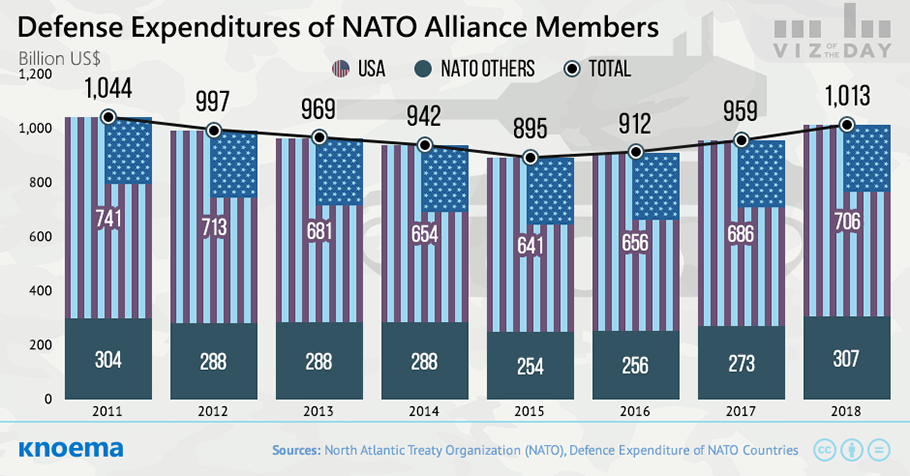 In July, after the NATO summit in Brussels, US President Donald Trump tweeted that "the United States is spending far more on NATO than any other country. This is not fair, nor is it acceptable." But, is the US spending more on NATO than other members? And, if so, is the US spending level unfair relative to that which the US—and the other 28 members—have agreed? Let's look at the data.
In July, after the NATO summit in Brussels, US President Donald Trump tweeted that "the United States is spending far more on NATO than any other country. This is not fair, nor is it acceptable." But, is the US spending more on NATO than other members? And, if so, is the US spending level unfair relative to that which the US—and the other 28 members—have agreed? Let's look at the data.
Measure 1: Defense Expenditures. In 2018,* the US will spend an estimated $706 billion on defense globally. The US defense budget represents US priorities and spending globally and not money spent for or on behalf of NATO or for the mutual defense of the alliance members. NATO-Europe is expected to spend $286 billion on defense in 2018.
- Personnel expenditures constitute the largest single category of anticipated US defense expenditures in 2018 (42.5%)—which includes pensions paid to retirees—followed by equipment and related R&D (26.8%).
- Defense infrastructure makes up only 1.3 percent of total US defense expenditures in 2018, down from 3.1 percent 2011.
Measure 2: Share of GDP. In 2014, NATO members agreed as a signal of political will and validation of the alliance to increase defense expenditures to at least two percent of GDP by 2024. According to 2018 estimates, by this measure a few countries have already met the commitment while other countries are still working up to the 2024 standard: the US, 3.5 percent; Greece, 2.3 percent; Estonia, 2.1 percent, and the UK, 2.1 percent.
Measure 3: Contribution to the NATO Common Funding. Based on an agreed GDP-based cost sharing formula, the largest share of direct funding of NATO's $2.5 billion Common Fund by the 29-member alliance** is from the largest economy: the United States. In 2017, the US contribution made up 22 percent of NATO's common fund, or about $550 million. Europe's total contribution was $1.8 billion. Learn more about direct funding to NATO here.
If the US President wants to argue in favor of alliance members more rapidly reaching a 2 percent minimum in defense spending in light of the threats posed to global security by non-alliance actors, that policy argument would supersede the data used herein to examine current commitments of NATO members.
*Figures for 2017 and 2018 are estimates. The NATO Europe and NATO total aggregates for 2017 include Montenegro, which became an ally member on 5 June 2017.
** The Defence Expenditure of NATO Countries dataset does not include Iceland.

